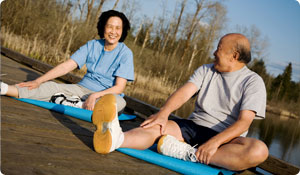
Though you may feel cautious, exercise could be one of the best things you can do if you have osteoporosis. That's because some exercises help preserve and strengthen your bones. However, some forms of physical activity can do more harm than good and what may be good for one person's bones may not be good for another's. Be sure to speak to your doctor before starting on any exercise program.
Key exercises for osteoporosis target the spine and hips, where fractures are most likely to occur. Other exercises focus on posture, to help realign the spine and strengthen the back and abdominal muscles.
Do...
Warm up before and cool down after any exercise session.
Vary the types of exercises you do, and include stretching and flexibility exercises in your program.
Focus on weight bearing exercises, which help strengthen your bones and muscles and can help improve balance and coordination. Weight-bearing exercises include:
- Hiking
- Stair climbing
- Dancing
- Low-impact step aerobics
Include resistance exercises in your regime, which have more effect on bone density than any other type of activity. Some resistance exercises use free weights, physiotherapy exercises balls, and elastic bands. Resistance exercises include:
- Leg press
- Seated rowing
- Machine squats
- Back extension
- Arm raises with free weights
Add more weight and resistance as you build up strength, rather than add more repetitions. For instance, if you are using weights, you perform the same number of repetitions as you progress but you increase the amount of weight used. The most benefit for bones comes from high-load, low-repetition training programs.
Work with a personal trainer until you can safely use weights and resistance aids on your own.
Don't...
Do exercises that require your head and shoulders to lean forward, such as crunches, sit-ups, and touching your toes. Instead, choose exercises that maintain your head and shoulders in a neutral position.
Do any activities that cause you to twist at the waist, such as golf, bowling, tennis and certain yoga positions and stretching exercises.
Do high-impact aerobic exercises, such as running and jumping or any type of fast-paced exercise that can put a lot of stress on your spine, hips and legs and put weak bones at high risk of fracture.
Sources:
Mayo Clinic. "Exercising with Osteoporosis: Staying Active the Safe Way." Web, June 2012
http://www.mayoclinic.com/health/osteoporosis/HQ00643/NSECTIONGROUP=2
Metcalfe, L. et al. "Postmenopausal Women and Exercise for prevention of Octeoporosis: The Bone, Estrogen, Strength Training (BEST) Study. ACSM's Health & Fitness Journal. May/June 2001:5(3) 6-14. Web June 2012
http://cals.arizona.edu/cpan/files/Metcalfe%20ACSM%20final%20article.pdf
Oregon State University: Better Bones and Balance. Web. June 2012
http://extension.oregonstate.edu/physicalactivity/bbb-faq





